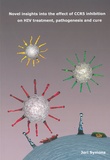Novel insights into the effect of CCR5 inhibition on HIV treatment, pathogenesis and cure

Symons, Jori
- Promoter:
- Prof.dr. E.J.H.J. (Emmanuel) Wiertz
- Co-promoter:
- Dr. M.J.G. (Monique) Nijhuis & dr. A.M.J. (Anne) Wensing
- Research group:
- Wensing Nijhuis , Wiertz
- Date:
- January 20, 2014
- Time:
- 14:30 h
Summary
The introduction of combination antiretroviral therapy (cART) in 1996 has significantly reduced HIV related morbidity and mortality in the Western world. Recent advances in antiretroviral treatment have resulted in a life expectancy of effectively treated HIV infected patients, comparable to those having other chronic diseases. There is a group of patients that have a slow progression towards AIDS if they are untreated. The presence of a heterozygous 32 nucleotide deletion in one of the CCR5 co-receptor genes is often seen in these long term non-progressors. This CCR5Δ32 results in a truncated gene product which is not expressed at the cellular surface. Homozygous CCR5Δ32 individuals are healthy and are largely resistant to HIV infection. These observations lead to the development of CCR5 antagonists as antiretroviral drugs. Maraviroc (MVC) is the first antiretroviral drug in clinical practice that targets this host chemokine receptor and only inhibits viral entry of CCR5 using HIV. One important consequence of the administration of CCR5 antagonists is the risk of selection of viral variants capable of using the alternative CXCR4 co-receptor, therefore, co-receptor tropism should be assessed before clinical use of the inhibitor. Furthermore, given the redundancies in the immune system, CCR5 is not critical for normal immune function and CCR5 based HIV curative strategies are now widely investigated. In this thesis we investigated the effect of inhibiting HIV binding to the CCR5 co-receptor on HIV treatment, pathogenesis and HIV cure. In a cohort of 63 patients MVC was well tolerated and phenotypic and genotypic assays that asses co-receptor tropism were comparable in predicting clinical outcome of MVC based antiretroviral therapy. Since genotypic tropism prediction was excellent in predicting clinical outcome we advise for practical reasons to perform genotypic tropism tests. Furthermore, independent genotypic tropism testing performed in triplicate slightly increases the detection of minority variants that use CXCR4 for viral entry. MVC inhibits HIV that uses CCR5 for viral entry, however the inhibitory effect of MVC on dual-tropic variants was unknown. We investigated the selective pressure and inhibitory effect of MVC in patients infected with a viral population that could use CXCR4. MVC was able to inhibit part of dual tropic viral populations and MVC selected rapidly for extreme CXCR4 using variants. MVC therapy intensification was thought to be beneficial for immunological non-responders to cART. We assessed the virological effect of MVC intensification in these patients. We found a significant difference in HIV transcription during MVC intensification in the placebo and MVC group. Currently, only one patient has been declared cured of an HIV infection. We assessed the role of co-receptor tropism in the cure of this patient who received stem cell transplantation with CCR5 CCR5Δ32/Δ32 stem cells. His new cells were fully resistant to the HIV population present prior to stem cell therapy. Our studies performed in this thesis give insight into the effect of CCR5 inhibition. The antiretroviral strategy of inhibiting CCR5 was found to be a good way to inhibit HIV and needs to be further investigated with respect to HIV cure.